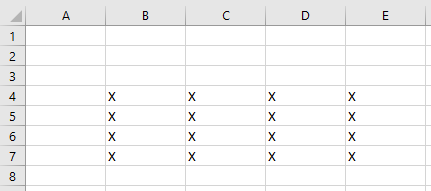Select individual cells on a Worksheet
The range returned by
worksheet.cells allows to select arbitrary cells on a worksheet. ….cells(R, C) returns a range that represents the cell at row R and column C. Because item is the default property of a Range object, ….cells(R, C) is equivalent to ….cells.item(R, C).
The following example chooses two cells that are used to define the upper left and bottom right cell of a range. Then, the cells in this range is assigned the value
X: public sub Main() ' {
dim cur_worksheet as worksheet
dim range_start as range
dim range_end as range
dim range_all as range
set cur_worksheet = activeSheet
' Note, instead of the explicit cur_worksheet.cells(...)
' the line can also be written just as
' cells(...)
' without cur_worksheet.
set range_start = cur_worksheet.cells( 4, 2) ' 4th row, 2nd column
set range_end = cur_worksheet.cells( 7, 5) ' 7th row, 5th column
set range_all = range(range_start, range_end)
range_all.value = "X"
activeWorkbook.saved = true
end sub ' }
Github repository about-MS-Office-object-model, path: /Excel/Worksheet/cells/select-cells.bas
